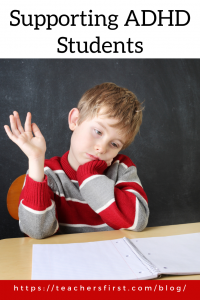Debbie Phelps, the mother of Olympic swimmer Michael Phelps, worked with her son to achieve his goals in and out of the classroom after he was diagnosed with ADHD at the age of nine. “The diagnosis made me want to prove everyone wrong. I knew that, if I collaborated with Michael, he could achieve anything he set his mind to,” Debbie Phelps stated in an interview for ADDitude.
Collaboration with families is critical to student success. Next to a student’s family, teachers are one of the most influential groups of people in his or her life. Success for students in and out of the classroom often depends on their ability to attend to tasks with minimal distraction. Struggles that students with ADHD face contributes to distractions that hinder their success. Characterized by problems with attention, hyperactivity, and impulse control, ADHD typically develops during childhood, but it may not manifest until adolescence or adulthood. Making sure students are on task with the purpose and objectives of learning experiences is important because it not only impacts their own learning, but potentially their classmates’ as well. Listed below are strategies to help you set all of your students up for success.
Breaks and Movement – All students benefit from breaks and movements. Go Noodle (reviewed here) is a fantastic resource for kindergarten through fifth grade for movement. Another resource called Brain Breaks (reviewed here) has activities for older students.
Consistent Expectations – It’s critical to make sure directions and expectations for students are clear and consistent. Provide students with an index card, Google Slide, or PowerPoint slide with the expectations or directions. Screencast directions for assignments or projects using Screencastify (reviewed here) so students can replay them to make sure they understand the assignment. Divide long-term projects and more extended activities into segments. Assign a completion goal for each part to help students remain on task.
Feedback – All students benefit from frequent feedback during learning experiences. It’s also important to reinforce positive behaviors. The archive of this Twitter chat on effective assessment and feedback strategies is full of ideas for providing timely feedback.
Engagement – Activating students’ interests in classroom assignments increases student engagement. Providing them with choices also helps students connect with the content during the learning experience. This archive from an OK2Ask webinar outlines how to use choice boards for differentiation.
Michael Phelps’s mom was a middle school teacher, and she worked closely with his teachers. “Whenever a teacher would say, ‘Michael can’t do this,’ I’d counter with, ‘Well, what are you doing to help him?’” she recalls.
Our students’ success depends on sound instructional design to best meet their needs. By incorporating the techniques shared above into our instructional and classroom management practices, we can improve both our students’ academic performance and behavior. How are you helping students with ADHD succeed in your classroom? We’d love to hear your strategies in the comments below!


